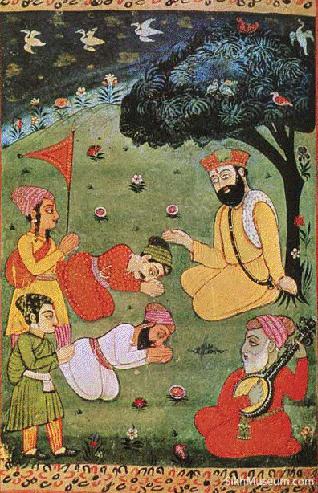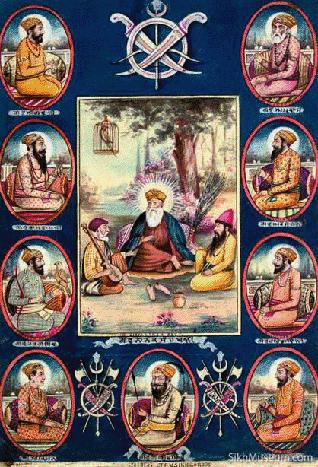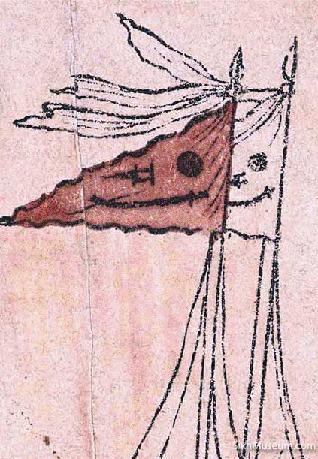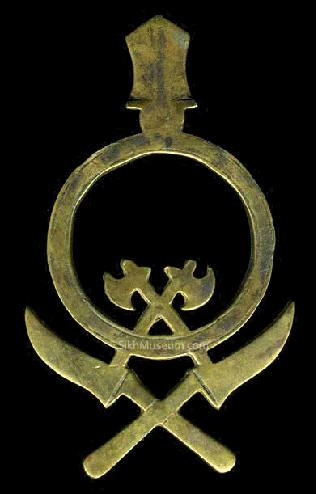
Images: Above - A flag depicted in an illustrated manuscript (B40), 1733. Below, 1st from bottom - late 19th-century military turban badge. 2nd - 19th-C woodcut shows Akal Takht's Miri-Piri flags. 3rd - late 19C print of Gurus shows a version of khanda.



History
Evolution of The Nishaan Sahib, The Sikh National Standard
by SANDEEP SINGH BRAR
Seen flying high outside every Sikh place of worship, the Nishan Sahib standard is a beacon of Sikh identity.
What is its significance and what is its history?
Those questions were the initial motivations for a study of the sacred flag of the Sikh Nation that has now culminated in a major new exhibit at SikhMuseum.com. The exhibit is the result of twelve years of painstaking research and is one of the largest studies of its kind undertaken on the subject that helps establish a new benchmark of understanding about the Nishan Sahib and its history.
Delving into the writings of the Gurus, early Sikh chronicles and travel accounts of European explorers, we get an understanding of the basis for the Nishan Sahib and the khanda emblem that we see today.
The flag as we know it today and its elements have a direct lineage to the Sikh Gurus.The exhibit uncovers the
early history of the Nishan Sahib and its spiritual connections.
Understand why weapons like the sword have had a special spiritual meaning for Sikhs and learn about the various weapons that have appeared on the Nishan Sahib.
With the establishment of Sikh rule in Punjab leading to the establishment of the Sikh Empire of Maharaja Ranjit Singh, we see early images of the Nishan Sahib for the first time in paintings and manuscripts.
Rebuilding Darbar Sahib after multiple destructions in the 1760’s, the Nishan Sahib was unfurled across the Land of The Five Rivers as Sikhs could now practice their religion free from persecution for the first time in almost two centuries.
By gathering together and studying a large collection of rare images of the Nishan Sahib, we discover trends and patterns that reveal interesting and unusual designs and emblems from various time periods, many of which have never been seen before by most Sikhs. View a diversity of objects related to the Nishan Sahib, from sculptures to Sikh coins to military emblems.
Rather than just being a broad survey of changing designs and emblems, the exhibit also delves into an analysis of emblems and banners that have often been mistaken for the Nishan Sahib or its khanda emblem. For example, the Aad Chand emblem worn by members of the Nihangs is often mistaken as an old style khanda. In fact it is not a khanda at all but a completely different symbol with its own history and meaning.
Learn what the Aad Chand symbol is, as understood and explained by the Nihangs themselves.
Another case of mistaken identity that the exhibit examines and contextualizes is the Lahore battle standards that the British captured during the Sikh Wars and took back to England to display as war trophies. Trace the history of these unusual banners, study their designs and delve into answering the question of why would Sikh flags have images of local Hindu deities on them.
During the research for this exhibit, a number of exciting discoveries were made including finding a photograph taken by an American tourist visiting Amritsar which is one of the very early images of the modern khanda emblem. Another thrill comes from viewing a turn of the century photograph of the Miri-Piri Nishan Sahibs at the Darbar Sahib, outside the Akal Takht, where one can clearly see unique and unexpected emblems on them.
Of the millions of people that visit Darbar Sahib every year, few are aware that inside the Darbar Sahib, there is actually a painting of Guru Gobind Singh with a Nishan Sahib. It is the only painting of human figures within the Darbar Sahib. View this stunning priceless painting and see how it leads to an important new discovery regarding an early Nishan Sahib symbol that was previously thought to represent the Sikh slogan of ‘Deg Tegh Fateh’.
While we may look at the Nishan Sahib and our modern khanda emblem today and think that they have always been the same, it seems much like our changing turban styles or our changing gurdwara architecture, our sacred flag has also continued to evolve over time, shaped by our history, our hopes and aspirations.
The visual and interactive nature of the exhibit conveys this sense, as one becomes a virtual time traveller across the centuries and with a few clicks of the mouse is able to encompass centuries of the history of the Nishan Sahib.
Visit the Nishan Sahib exhibit at SikhMuseum.com.
[The author is the curator of SikhMuseum.com and the creator of the world’s first Sikh website, sikhs.org]
Conversation about this article
1: Ari Singh (Sofia, Bulgaria), June 24, 2011, 12:07 PM.
Interesting article. I think it is also necessary to research the origin of the Persian symbol which is very similar to our Khanda. And the Persians were our neighbours then and perhaps the main influence on our culture.
2: Sandeep Singh Brar (Canada), June 24, 2011, 1:06 PM.
Already covered in the exhibit ... see the Mistaken Identity section. The Persian symbol has historically been a lion. The khanda-like emblem that they now use is a modern design created in the 1980's. Please see the exhibit for further details.
3: Brijinder Singh (New York, U.S.A.), June 24, 2011, 1:57 PM.
The Iranian symbol is a new sign for "Allah". I had a Persian roommate once who explained it to me. Interesting that the colors of the Nishan Sahib changed from red to white, and now saffron. I wonder if the latter is a new development, as the Nihangs fly a blue one in front of their gurdwaras.
4: Ari Singh (Sofia, Bulgaria), June 24, 2011, 4:19 PM.
Ayatollah Khomeini's family had migrated to India from Persia many centuries ago. While in India, he added Hind to his name affectionately and wrote many books. Then he went back to Iran. Isn't it possible that he had seen the khanda while in India and approved of the new Iranian symbol as it symbolizes martial spirit of the warrior Sikhs? Many Iranians and Arabs know that he was greatly influenced by Indian culture and often consider him as Indian in origin.
5: Manjit Singh BaraPindia (Canada), June 24, 2011, 5:59 PM.
Though the Iranian emblem looks very similar to the Sikh Khanda, each part of those represents different things.
6: Ari Singh (Sofia, Bulgaria), June 25, 2011, 6:05 AM.
I know a man who tattooed the khanda on his arms and back and he had problems with the Iranians until the police intercepted!
7: Blighty Singh (London, United Kingdom), June 25, 2011, 6:15 AM.
The Persians wern't just our neighbours, Ari Singh. Our Punjab was very much part of Persia ... and the richest Persian province at that. This modern day business of looking south to India is very unatural for Punjab. As such, whilst I think Sandeep Singh ji has done a truly excellent job with both the exhibit and the museum generally, I do think the Persian link has been too quickly brushed away under the heading 'mistaken identity'. If you look at Sikh words generally ... such as Sardar, Dastar, etc., you can see that the early Sikhs were keen to bypass the areas just to the north of them and go directly to Persia to get their words and inspiration. In the same way, I do get the feeling that the Sikhs were more than aware of the ancient Persian Tulip symbol which symbolized bravery and shaheeds. This tulip symbol, often made with swords, fitted in perfectly with the Sikh ideal.
8: Brijinder Singh (New York, U.S.A.), June 25, 2011, 11:14 AM.
I was looking through the exhibit posted on the homepage, and I was really intrigued by the coins from the Mughal era and the Sikh Raj. They have a lotus flower on them that looks just like a Khanda. However, the development of the Khanda as we know it seems to have taken place within the past century. This new Khanda image replaced the old one on the Nishan Sahib. It is fascinating. Makes me realize that there is so much of our history that is not well understood. There may be more to this story, yet to be uncovered. If only our history was better documented.


